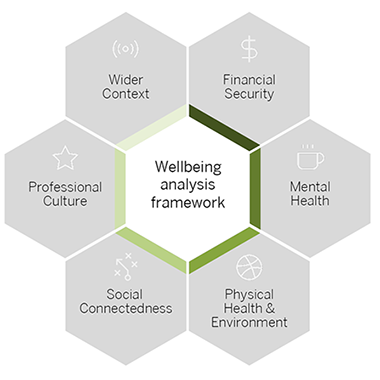A new toolkit that provides a framework to measure employee wellbeing is launched by Highsight Analytics and the University of Cambridge Psychometrics Centre at Cambridge Judge Business School.

While employee wellbeing has recently vaulted to the forefront of organisational thinking, many firms have yet to implement the measurement practices needed to maximise their wellbeing initiatives. A new “toolkit” launched today (1 December) by Highsight Analytics and the University of Cambridge Psychometrics Centre addresses this emerging market need by providing organisations with support for the formulation of wellbeing strategies and, crucially, the ongoing measurement of their effectiveness
The toolkit comprises a framework for wellbeing measurement, drawn from scientific research and industry engagement, and a set of supporting resources such as data dictionaries, self-assessments and templates for stakeholder management. At the core is a diagnostic that collates information on various factors ranging from financial security to mental health to social connectedness. This provides a report to organisations looking to assess and improve the effectiveness of their wellbeing strategy (see illustration).
By completing the diagnostic, organisations can receive a report on the capability, maturity and strategic positioning of their wellbeing function, with quantitative benchmarks and recommendations as to next steps.
A wake-up call on wellbeing
The initiative to better measure wellbeing reflects the wake-up call that the pandemic provided for employees and employers around the world. Among the many changes that this brought in society, one of the most under-studied and under-prioritised aspects of work was suddenly brought to the fore. Wellbeing went from a tick-box or compliance issue to a strategic imperative and competitive differentiator.
Initially, organisations were forced to take a series of reactive and at times inconsistent measures in order to “fight fires” and cope with the pandemic’s shock to the labour market. Later, these initiatives became more coherent and intentional, and generated residual energy and internal pressures to make lasting changes, or “build back better”.
A shift in management theory away from work-life balance
Underpinning these recent initiatives is a slower and more gradual shift in management theory and practice – from hours-based thinking around work-life balance to more complex psychological and cultural concepts like inclusivity, fulfilment, self-actualisation and belonging. This combination of gradual trends and immediate needs has increased the complexity of the landscape and transformed the wellbeing agenda in many organisations.
In this dynamic environment, many organisations are seeking a structure in which to frame their wellbeing initiatives, and a set of measures against which to track and compare their efficacy. For some, this comes under the umbrella of demonstrating impact in the “S” of Environmental, Social and Governance (ESG) factors. For others, it is a standalone agenda whose currency and momentum is fundamentally transforming how people think about the role that work plays in their life.
How input from participating firms fed into the toolkit
The toolkit can be used for internal diagnostic purposes as well as being part of a data-driven benchmarking exercise with peer organisations, a process that Highsight and the Psychometrics Centre have recently completed with several global strategy consulting firms.
By conducting a series of group consultations and one-on-one interviews with senior HR and wellbeing representatives from participating firms, Highsight and Cambridge generated new insights on how wellbeing issues are talked about and acted upon by business leaders. Through candid and structured discussion between peers, participating firms helped each other to identify the most pressing issues in financial security, mental health, social connectedness, professional culture and other aspects of workplace wellbeing.
The Global Wellbeing lead for one of the participating firms stated:
“We found the Wellbeing Framework to be very useful when we took stock of our current wellbeing initiatives, it helped us align and gave us some food for thought as to how to establish who should be involved in wellbeing initiatives and why.”
These discussions were complemented by tools that drew on the Psychometrics Centre’s research and expertise in people analytics, such as a data sources register and self-assessment of strategic positioning for the wellbeing function.
The exercise demonstrated the potential for such a framework to enhance the ability of organisations to scientifically measure and therefore take steps to maximise the positive impacts of their policies on employee wellbeing.
Another senior wellbeing professional who participated in the exercise noted that:
“As with other firms, on the back of the COVID challenges we have been launching a number of employee wellbeing programmes. With a global workforce we need to navigate not only cultural differences but also data ownership challenges and unavoidable varied maturity of certain local wellbeing programmes.
“The wellbeing programme developed by Highsight and Cambridge has been useful in pulling varied threads together and enabling us as a global wellbeing team to understand the nuances of data and maturity at the local level.”
Why there is little scientific rigour in measuring wellbeing
Engaging with consultancies which already have a data-driven mindset to most organisational challenges was interesting for the research team. Delving into the detail of the framework revealed that while wellbeing is very high on the agenda, there is still little scientific rigor in how it is measured. For the most part, communication with employees remains disparate at different levels of the organisation. A wide range of initiatives and practices have developed as a reaction to the pandemic, and some organisations are finding that they now have a big job to consolidate these many positive efforts into a coherent strategy.
One clear outcome was that, while surveys and assessments of the employee population were commonplace, it was virtually unheard of for organisations to be using psychometric techniques to standardise the raw data they gather into reliable and valid measurements of latent traits. This is the strategic need that the Highsight-Cambridge initiative seeks to address.
Do you represent a professional services firm that would be interested in collaborating on the toolkit?
Following the success of the consultancy pilot, Highsight and Cambridge are launching the diagnostic as a standalone offering to interested parties.
At the same time, they are seeking to collaborate with companies in other professional services organisations where wellbeing is high on the agenda, such as the legal and accounting sectors. Many of the challenges uncovered thus far are undoubtedly common across industries, so the research team are very interested to hear from any organisations on the path to integrating psychology and data science with their wellbeing agenda.


